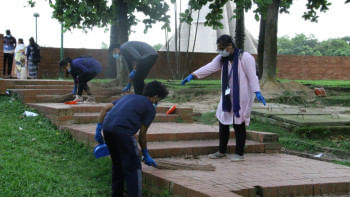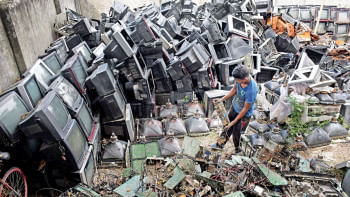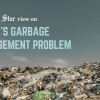A digital solution to Dhaka’s waste problem

In a densely populated city like Dhaka, waste collection, transportation, recycling, and disposal requires an efficient waste management system. Improper waste disposal and poorly managed landfills pollute the ground, water and air, causing many health and environmental problems. The city must, therefore, use modern approaches to ensure the health and safety of its inhabitants by creating a cleaner and greener environment while saving money and other resources.
Currently, the waste generated in Dhaka city is collected without segregation, dumped at various locations across the city, and finally transported to landfills in an apparently unstructured manner. The problem is exacerbated due to the lack of awareness, motivation, and poor attitudes of the city's inhabitants to practise proper waste management. But people's motivations and attitudes can be changed by adopting a creative incentive policy, whereby desired behaviours could be reinforced and new behaviours encouraged.
In this context, we propose an innovative model of waste management that is low-cost, robust, technology-based, reliable, and sustainable. The Internet of Things (IoT) technology, in fact, can be used creatively to improve Dhaka's current waste management system without introducing major alterations to the core structure. IoT refers to physical objects that are equipped with sensors, processing power, software, and other technologies that can communicate with other devices and systems over the internet or other communication networks. Mobile applications, modified primary vehicles, smart secondary transfer stations, and monitoring centres make up the system. A powerful message queuing telemetry transport (MQTT) cloud-based platform, such as the Amazon Web Services (AWS), may be used to coordinate technologies, manage data, and perform the needed computations. In other words, real-time data can be tracked from each piece of hardware linked to the IoT server independently, and their values combined or correlated to draw statistical and logical conclusions and solutions to produce data-driven economic value, as well as making predictions of future waste generation and its efficient handling.
Primary vehicle modifications
Not segregating rubbish at any stage is a shortcoming in the traditional garbage collection mechanism. The best way is to segregate waste at the source (i.e. household level). The primary vehicles of household waste collectors can be modified by compartmentalisation of the waste bins (or colour-coded garbage bags) to separate garbage such as biowaste, plastics, and scheduled waste. Scheduled waste means items such as glass collected on Monday, electronic items on Tuesdays, metals on Thursday, etc. Each container would possess one load cell sensor connected to the microcontroller in an embedded system. We can demonstrate this system using Nodemcu, a microcontroller which converts the weights of classified waste into QR codes with security codes that change regularly like OTPs (one-time passwords) that can be verified by the QR scanner in the app. We can connect to the system using the internet through its inbuilt Wi-Fi module. The internet can be accessed via a hotspot on the garbage collector's mobile phone. The routes of the primary vehicles can be accessed by the control centre via GPS tracking.

'N0 waste!' mobile app
Lack of awareness and motivation seems to be the root cause of Dhaka city's waste management problem. From our perspective, the generated waste products are the raw materials for making new products. For this, we introduce our "N0 waste!" app with the following functionality:
1. Users can scan the QR code generated in the primary collection vehicle.
2. The application will convert to values by verifying the OTP associated with the QR code with the cloud, which deploys the app and primary vehicle circuit.
3. Points will be generated in the user domain with respect to the type of waste and also to calculate community (e.g. a predefined zone) ranking. These reward points may be used to make purchases at supermarkets, pay for university fees, and so on by individual households. Community points may be used to prioritise community projects (building or repairing schools, providing priority healthcare, enabling greater security, etc). The money for these rewards would come from selling the separated rubbish to recycling plants or from new products generated from the rubbish by start-ups with high-value addition. For example, the segregated biowastes can be used as the raw materials for bio-methane production. The slurry can be utilised as agricultural compost. This circular process indeed has the potential to increase the country's GDP and job prospects.

Smart secondary transfer station
The overflowing secondary transfer stations (STS) (the large waste bins) is another important issue. Garbage may accumulate in the large bins by the roadside, emitting foul odours and posing a health risk to the city residents. It also looks awful. We propose a Smart STS with an ultrasonic distance sensor on top of the bins to monitor the tank's state and a load cell at the bottom to measure the weight. The STS status will be sent to the controlling and monitoring centre when a trigger point is reached so that trucks can be deployed to clear the bins. Also, the system will facilitate the cross verification of STS weight with the weight the waste collectors claim to have collected to prevent malpractice.
Controlling and monitoring centre
The weight and type of waste data may facilitate real-time monitoring of segregated waste and its flow through the system, solving problems of coordination, calculating the economy of collection, comparison of market price of virgin raw materials with that of recycled materials, total revenue generated from the recycling, and prediction of waste quantity in the future by trend analytics. The public and private stakeholders may get this data on their laptops, tablets, PCs, and mobile phones for transparency. The efficacy of the system can be demonstrated using simulated data. Data visualisation can also be availed using business intelligence tools like Tableau, Power BI, etc.
The innovative solution that we propose, combined with a point-based incentive system, may fuel the economy of Dhaka and reward its residents in a variety of ways. We also believe the system can create new and decent jobs, help establish training centres to facilitate the technical training for hardware technicians, create new recycling start-up companies, and enable the greening of Dhaka city, beautifying it, and curbing the health risks that the present system poses. Team efforts with multidisciplinary perspectives are now imperative to tackle Dhaka's growing waste menace.
This op-ed, the final instalment in a four-part series, resulted from the authors' participation in the 23rd ASEF Summer University (ASEFSU23) interdisciplinary hackathon on "Livable Cities for a Sustainable Future" envisioned by Asian and European young professionals and students.
Sainul Abid is studying for an MSc in cognitive science at the Centre of Behavioural and Cognitive Sciences in the University of Allahabad, India, and is a STEM trainer.
Dr Syed Saad Andaleeb is distinguished professor emeritus at Pennsylvania State University and former vice-chancellor of Brac University.

 For all latest news, follow The Daily Star's Google News channel.
For all latest news, follow The Daily Star's Google News channel. 








Comments